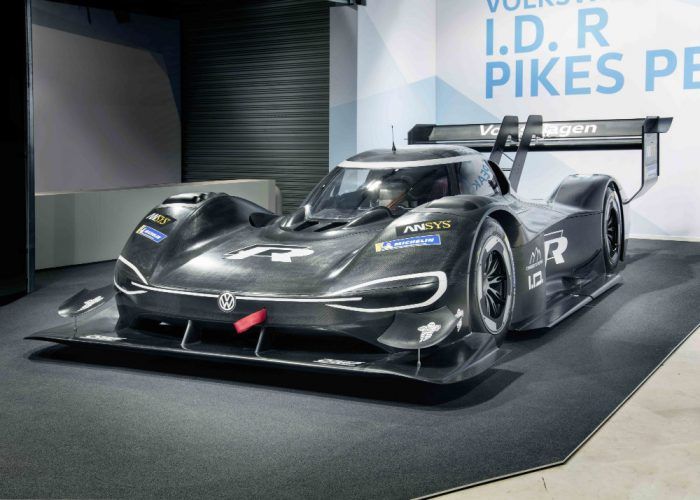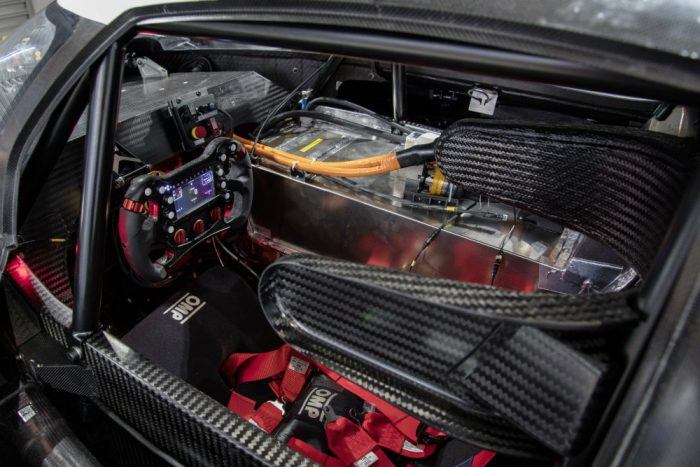Racing improves the breed. That is a known truth in both horse and automotive racing. I have long maintained the best way to improve and market electric cars is to race them. It looks like Volkswagen has heard my pleas, because they’ve just rolled out this nasty looking, all-electric race car to have a crack at the Pikes Peak International Hill Climb.
Fearless Few
The Pikes Peak race, for those of you bereft of this knowledge, is one of the last “You’re going to die!! You’re crazy!!” racing events on the planet. It’s a twelve-and-a-half mile “Race To The Clouds” with a finishing line over 14,000 feet. There are sections of the run that are crazy, Glen Cove and The Ws, and then there are the sections of the run that are borderline suicidal: The Devil’s Playground, Bottomless Pit, etc. You get those turns wrong, and by the time your wreckage stops bouncing your clothes will be out of style.
You need confidence and skill and a great amount of bravery to take this place on. And those who have, and succeeded, have all three of those in large quantities; racers like Unser (literally the entire family) and Walter Rohrl and Ari Vatanen and Michelle Mouton and Sébastien Loeb. Loeb, arguable the greatest rally driver of all time, holds the outright course record at Pikes Peak. Volkswagen has the idea that they should hold, if not the outright record, then at least the EV record.
Power & Performance
Uninterestingly named the “I.D. R Pikes Peak,” it is a particularly nasty looking little beast. The IDRPP looks like a 7/8th scale model of a Le Mans car, only with the driver sitting smack in the middle (it looks) and a no-holds-barred approach to aerodynamics. There’s tons of subtle aero work here and there, and then you get to that rear wing and realize “subtle” has nothing to do with this car.
The I.D. R Pikes Peak weighs less than 2,500 lbs., cranks out 680 horsepower and 479 lb-ft. of torque, and hits 60 in 2.25 seconds. VW says it is “faster than even Formula 1 and Formula E cars,” to which I say, yes, but that’s in a straight line to 60. Racing is more than that. With those numbers backing up the Wolfsburg company, they hope to beat the existing electric car record (8:57.118) in the annual Race to the Clouds, if not the outright record.
VW points out that the IDRPP has not one, but two electric motors, generating the system’s capacity of 680 horsepower. For EVs, that’s not uncommon, given that electric motors, even powerful ones, are about the size of a picnic basket. Bizarrely, this is not the first time VW has run at Pikes Peak with a twin-engine car. It’s not even the second. In 1985, 1986, and 1987, Volkswagen engineers opted for two power units in a twin-engine Golf that VW described as “sensational.” You say “sensational,” I say “mental.” Tomayto, Tomahto.
Battery Technology
Power storage is accomplished via lithium-ion batteries that are similar to production EVs. Volkswagen says power density is the crucial factor for the system when producing high voltage, and Li-Ion batts are just the ticket. They further point out that around 20 percent of the electric energy needed will be generated during the drive, the key to that being energy recovery. The IDRPP uses the same energy recovery scheme found in everyday Teslas and Priuses, turning the electric motors into generators when you hit the binders, converting some of the braking energy back into electricity, and then storing this in the battery.
Lone Wolf
Romain Dumas was chosen for the driving duties. Dumas, a 39-year-old Frenchman, seems like an odd choice at first. Normally, people who run at Pikes Peak are rally types (i.e. completely nerveless Scandinavians with ice water for blood and zero self-preservation instinct), but Romain Dumas is a former 24 Hours of Le Mans champion and defending Pikes Peak champion. So he does seem like a good choice.
“It was absolutely fantastic to see the completed I.D. R for the first time, and to take it out for its first spin,” Dumas said. “What Volkswagen has managed to put together from scratch over the past few months has my greatest respect.”
Precise Calculations
And if running a race that features no guard rails and drops measured in the thousands of feet isn’t difficult enough, bear in mind that testing on the hill climb is very incomplete. You can only run on certain sections and the bulk of the testing is not done on Pikes Peak at all, but at racetracks. So, it’s educated guesswork, but guesswork nonetheless. I hope everybody has their sums right.
A 4,720 vertical-foot climb, 156 corners, only a single run is allowed, sunshine at the start but up at the 14,115-foot summit of Pikes Peak it can be below freezing.
The Pikes Peak International Hill Climb gets underway on June 24th in Colorado Springs, Colorado. What’s not to love?
“We now have a packed schedule of testing ahead of us and I am looking forward to every meter,” Dumas said.
Tony Borroz has spent his entire life racing antique and sports cars. He is the author of Bricks & Bones: The Endearing Legacy and Nitty-Gritty Phenomenon of The Indy 500, available in paperback or Kindle format. His forthcoming new book The Future In Front of Me, The Past Behind Me will be available soon. Follow his work on Twitter: @TonyBorroz.
Photos & Source: Volkswagen of America, Inc.
from Automoblog.net https://ift.tt/2vUnLmt


No comments:
Post a Comment